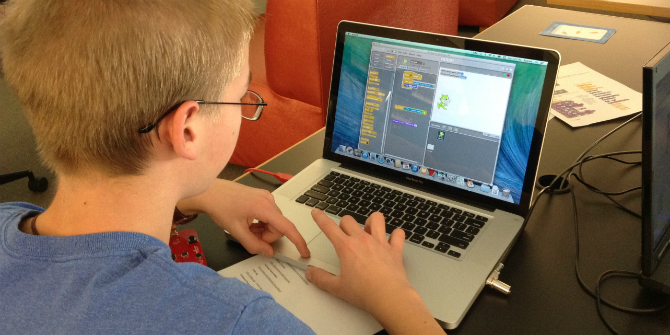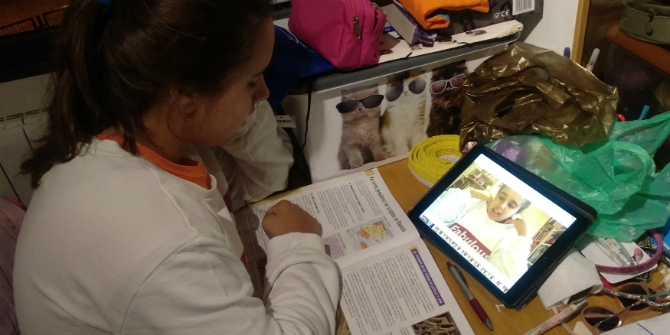 Nathan W. Fisk discusses his book, ‘Framing internet safety’, which just came out in the UK yesterday. He argues for recognising the ways in which children’s online and offline lives are inseparably linked, and highlights the need to listen to children about the problems they face, as they often know better than anyone what those are. Nathan is Assistant Professor of Cybersecurity Education at the University of South Florida. [Header image credit: A. County, CC BY-NC-ND 2.0]
Nathan W. Fisk discusses his book, ‘Framing internet safety’, which just came out in the UK yesterday. He argues for recognising the ways in which children’s online and offline lives are inseparably linked, and highlights the need to listen to children about the problems they face, as they often know better than anyone what those are. Nathan is Assistant Professor of Cybersecurity Education at the University of South Florida. [Header image credit: A. County, CC BY-NC-ND 2.0]
I can still remember the first time I encountered the word ‘cyberbullying’, back in my undergraduate years studying Information Technology. As a kid who had spent much of my high school years online, obsessively reading Wired magazine and tinkering with computers at every opportunity, the term was immediately laughable. Only someone completely detached from youth and online culture would come up with a term like that – ‘cyber-’ was so 1994 – I couldn’t imagine it ever really being taken seriously. So the events of the decade or so that followed came as something of a surprise – with the term cyberbullying becoming widely used, I found myself studying it throughout what would become an academic career.
Understanding online risks
I remain sceptical concerning cyberbullying and other forms of internet safety risks, not because I believe children don’t face problems as they go online, but because they represent ways of thinking about children, technology and social life that fail to connect with their lived experiences. If children don’t develop ideas about internet safety, where do our ideas about children and technological risk come from, how are they used, and what kinds of assumptions about what children do online are built into them?
 In Framing internet safety I answer these questions. In contrast to danah boyd’s work in It’s complicated, which focused more on children themselves, my book works to put ideas about children and online danger in social context, analysing youth internet safety policy and curricula throughout the history of the personal computer.1
In Framing internet safety I answer these questions. In contrast to danah boyd’s work in It’s complicated, which focused more on children themselves, my book works to put ideas about children and online danger in social context, analysing youth internet safety policy and curricula throughout the history of the personal computer.1
Adult efforts to understand and manage the risks faced by children online historically imagine separate online and offline lives, failing to recognise the ways that the two are inseparably linked. As children have found their social spaces shrinking generation on generation, they have turned to online platforms to ‘hang out’, communicate and participate in social life away from adult supervision. Their lives, like those of adults, play out on and are supported by information technologies, typically in positive ways.
It makes little sense therefore to separate and police the online lives of children without paying close attention to what they actually experience online, and the ways some of them are made vulnerable to various kinds of abuse.
Online and offline problems
By focusing on technology and failing to talk to young people about their problems, we risk losing sight of the problems they face such as cyberbullying and online predation. Other more complex social problems, including the disempowerment and isolation of some young people, forms of ‘offline’ violence and social and economic inequality, are often the underlying causes of what can look like ‘cyber-’ problems as children live out their lives online. This is precisely what makes technical explanations of the risks young people face so attractive – controlling technology and policing children are often easier to manage than more difficult and necessary forms of social or educational reform.
While there are elements of online communication that need more attention, and that create new problems for young people, they often know better than anyone what those problems are. Curricula and policy that start with the ‘cyber-’ and assume that online and offline lives are separate have often done more to allow adults to further peer into once private youth spaces than they have to actually help or protect children.
Protecting or surveillance
With adults increasingly watching every element of young people’s lives, it becomes more difficult for them to maintain what Nissenbaum describes as ‘contextual integrity’ – the ability to decide for themselves what is appropriate in a private space. As parents imagine future employers and college recruiters reading through ‘undeletable’ online profiles, children are expected to maintain adult ‘appropriateness’ online, in turn, shaping and policing their offline lives through the development of ‘personal brands’.
Despite what might appear to be something of a cynical description of a surveillance society, the on-the-ground reality of everyday technology use was far more positive for the parents and children I spoke with. Parents, while often concerned that they did not know enough, or were not doing enough, felt confident in their abilities to supervise and guide their children, online and off. Children were largely confident in their abilities to protect themselves, and actively wanted adult guidance and tools to help navigate their mediated social lives – although they were also frustrated by the failure of adults to actually listen to their concerns.
Concerns over internet safety offer a moment to re-evaluate, to critically think through – together with children themselves – the kinds of social lives we want children to have, and the ways in which those lives will provide them with opportunities in the future.
Notes
¹ Framing internet safety: The governance of youth online was published in December 2016, and is available via Amazon.com and MIT Press.






